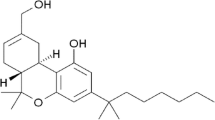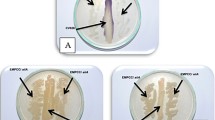Abstract
In order to adapt to different environments, Vibrio parahaemolyticus employed a complicated quorum sensing system to orchestrate gene expression and diverse colony morphology patterns. In this study, the function of the putative quorum sensing signal synthase gene cqsA (VPA0711 in V. Parahaemolyticus strain RIMD2210633 genome) was investigated. The cloning and expression of V. parahaemolyticus cqsA in Escherichia coli system induced the production of a new quorum sensing signal that was found in its culture supernatant. The signal was purified by high performance liquid chromatography methods and determined to be 3-hydroxyundecan- 4-one by indirect and direct mass spectra assays. The deletion of cqsA in RIMD2210633 changed V. parahaemolyticus colony morphology from the classical ‘fried-egg’ shape (thick and opaque in the center, while thin and translucent in the edge) of the wild-type colony to a ‘pancake’ shape (no significant difference between the centre and the edge) of the cqsA deleted colony. This morphological change could be restored by complementary experiment with cqsA gene or the signal extract. In addition, the expression of opaR, a well-known quorum sensing regulatory gene, could be up-regulated by cqsA deletion. Our results suggested that V. parahaemolyticus used cqsA to produce 3-hydroxyundecan-4-one signal and thereby regulated colony morphology and other quorum sensing-associated behaviors.
Similar content being viewed by others
Change history
02 January 2020
In the article by Wu <Emphasis Type="Italic">et al.</Emphasis> published in Journal of Microbiology 2019; 57, 1105–1114, the figure 8 is unfortunately incorrect. The figure 8 should be corrected as below.
References
Bassler, B.L., Wright, M., Showalter, R.E., and Silverman, M.R. 1993. Intercellular signaling in Vibrio harveyi: sequence and function of genes regulating expression of luminescence. Mol. Microbiol.9, 773–788.
Boles, B.R. and McCarter, L.L. 2002. Vibrio parahaemolyticus scr- ABC, a novel operon affecting swarming and capsular polysaccharide regulation. J. Bacteriol.184, 5946–5954.
Chen, Z., Wang, L., Zhang, Y., Feng, J., Yang, R., Chang, D., An, L., Liu, C., and Zhou, D. 2014. Establishment of a method for gene complementation in Vibrio parahaemolyticus. J. South Med. Univ.34, 70–74.
Duan, F. and March, J.C. 2010. Engineered bacterial communication prevents Vibrio cholerae virulence in an infant mouse model. Proc. Natl. Acad. Sci. USA107, 11260–11264.
Enos-Berlage, J.L. and McCarter, L.L. 2000. Relation of capsular polysaccharide production and colonial cell organization to colony morphology in Vibrio parahaemolyticus. J. Bacteriol.182, 5513–5520.
Ferreira, R.B.R., Antunes, L.C.M., Greenberg, E.P., and McCarter, L.L. 2007. Vibrio parahaemolyticus ScrC modulates cyclic dimeric GMP regulation of gene expression relevant to growth on surfaces. J. Bacteriol.190, 851–860.
Fuqua, W.C. and Winans, S.C. 1994. Quorum sensing in bacteria: the LuxR-LuxI family of cell density-responsive transcriptional regulator. J. Bacteriol.176, 269–275.
Gode-Potratz, C.J., Chodur, D.M., and McCarter, L.L. 2010. Calcium and iron regulate swarming and type III secretion in Vibrio parahaemolyticus. J. Bacteriol.192, 6025–6038.
Gode-Potratz, C.J. and McCarter, L.L. 2011. Quorum sensing and silencing in Vibrio parahaemolyticus. J. Bacteriol.193, 4224–4237.
Guvener, Z.T. and McCarter, L.L. 2003. Multiple regulators control capsular polysaccharide production in Vibrio parahaemolyticus. J. Bacteriol.185, 5431–5441.
Henke, J.M. and Bassler, B.L. 2004a. Three parallel quorum-sensing systems regulate gene expression in Vibrio harveyi. J. Bacteriol.186, 6902–6914.
Henke, J.M. and Bassler B.L. 2004b. Quorum sensing regulates type III secretion in Vibrio harveyi and Vibrio parahaemolyticus. J. Bacteriol.186, 3794–3805.
Higgins, D.A., Pomianek, M.E., Kraml, C.M., Taylor, R.K., Semmelhack, M.F., and Bassler, B.L. 2007. The major Vibrio cholerae autoinducer and its role in virulence factor production. Nature450, 883–886.
Jahan, N., Potter, J.A., Sheikh, M.A., Botting, C.H., Shirran, S.L., Westwood, N.J., and Taylor, G.L. 2009. Insights into the biosynthesis of the Vibrio cholerae major autoinducer CAI-1 from the crystal structure of the PLP-dependent enzyme CqsA. J. Mol. Biol.392, 763–773.
Kelly, R.C., Bolitho, M.E., Higgins, D.A., Lu, W., Ng, W., Jeffrey, P.D., Rabinowitz, J.D., Semmelhack, M.F., Hughson, F.M., and Bassler, B.L. 2009. The Vibrio cholerae quorum-sensing autoinducer CAI-1: analysis of the biosynthetic enzyme CqsA. Nat. Chem. Biol.5, 891–895.
Kernell Burke, A., Guthrie, L.T.C., Modise, T., Cormier, G., Jensen, R.V., McCarter, L.L., and Stevens, A.M. 2015. OpaR controls a network of downstream transcription factors in Vibrio parahaemolyticus BB22OP. PLoS One10, e0121863.
Liu, X., Gao, H., Yang, L., Zhang, Y., Tan, Y., Guo, Z., Huang, X., Yang, R., and Zhou, D. 2011. Establishment of a suicide vector-based gene knockout method in studies of Vibrio parahaemolyticus. Acta Lab. Anim. Sci. Sin.19, 188–192.
Livak, K.J. and Schmittgen, T.D. 2001. Analysis of relative gene expression data using real-time quantitative PCR and 2-ΔΔCT method. Methods25, 402–408.
Makino, K., Oshima, K., Kurokawa, K., Yokoyama, K., Uda, T., Tagomori, K., Iijima, Y., Najima, M., Nakano, M., Yamashita, A., et al. 2003. Genome sequence of Vibrio parahaemolyticus: a pathogenic mechanism distinct from that of V. Cholerae. Lancet361, 743–749.
McCarter, L.L. 1998. OpaR, a homolog of Vibrio harveyi LuxR, controls opacity of Vibrio parahaemolyticus. J. Bacteriol.180, 3166–3173.
McCarter, L.L. 2004. Dual flagellar systems enable motility under different circumstances. J. Mol. Microbiol. Biotechnol.7, 18–29.
McCarter, L.L. and Silverman, M. 1990. Surface-induced swarmer cell differentiation of Vibrio parahaemolyticus. Mol. Microbiol.4, 1057–1062.
Miller, M.B., Skorupski, K., Lenz, D.H., Taylor, R.K., and Bassler, B.L. 2002. Parallel quorum sensing systems converge to regulate virulence in Vibrio cholerae. Cell110, 303–314.
Milton, D.L. 2006. Quorum sensing in vibrios: complexity for diversification. Int. J. Med. Microbiol.296, 61–71.
Milton, D.L., Chalker, V.J., Kirke, D., Hardman, A., Camara, M., and Williams, P. 2001. The LuxM homologue VanM from Vibrio anguillarum directs the synthesis of N-(3-hydroxyhexanoyl) homoserine lactone and N-hexanoylhomoserine lactone. J. Bacteriol.183, 3537–3547.
Ng, W., Perez, L.J., Wei, Y., Kraml, C., Semmelhack, M.F., and Bassler, B.L. 2011. Signal production and detection specificity in Vibrio CqsA/CqsS quorum-sensing systems. Mol. Microbiol.79, 1407–1417.
Philippe, N., Alcaraz, J.P., Coursange, E., Geiselmann, J., and Schneider, D. 2004. Improvement of pCVD442, a suicide plasmid for gene allele exchange in bacteria. Plasmid51, 246–255.
Spirig, T., Tiaden, A., Kiefer, P., Buchrieser, C., Vorholt, J.A., and Hilbi, H. 2008. The Legionella autoinducer synthase LqsA produces an a-hydroxyketone signaling molecule. J. Biol. Chem.283, 18113-18123.
Su, Y. and Liu, C. 2007. Vibrio parahaemolyticus: a concern of seafood safety. Food Microbiol.24, 549–558.
Trimble, M.J. and McCarter, L.L. 2011. Bis-(3??-5??)-cyclic dimeric GMP-linked quorum sensing controls swarming in Vibrio parahaemolyticus. Proc. Natl. Acad. Sci. USA108, 18079–18084.
Wang, L., Zhou, D., Mao, P., Zhang, Y., Hou, J., Hu, Y., Li, J., Hou, S., Yang, R., Wang, R.,et al. 2013. Cell density- and quorum sensing- dependent expression of type VI secretion 2 in Vibrio parahaemolyticus. PLoS One8, e73363.
Wu, Q., Wu, K., Ye, Y., Dong, X., and Zhang, J. 2009. Quorum sensing and its roles in pathogenesis among animal-associated pathogens - a review. Acta. Microbiol. Sin.49, 853–858.
Wu, K., Wu, Q., Zhang, J., and Xu, X. 2015. Research on prokaryotic expression of Vibrio parahaemolyticus and N-acyl-homoserine lactone identification. Mod. Food Sci. Technol.31, 29–35.
Zhang, Y., Qiu, Y., Tan, Y., Guo, Z., Yang, R., and Zhou, D. 2012. Transcriptional regulation of opaR, qrr2-4 and aphA by the master quorum- sensing regulator OpaR in Vibrio parahaemolyticus. PLoS One7, e34622.
Zhu, J. and Mekalanos, J.J. 2003. Quorum sensing-dependent biofilms enhance colonization in Vibrio cholerae. Dev. Cell5, 647–656.
Acknowledgements
This study was supported by the National Natural Science Foundation of China (No. 31760492), the Natural Science Foundation of Guangdong Province (No. S2012030006235), and the Science and Technology Planning Project from Health and Family Planning Commission of Jiangxi Province (No. 20172008).
Author information
Authors and Affiliations
Corresponding authors
Additional information
Supplemental material for this article may be found at http://www.springerlink.com/content/120956.
Electronic supplementary material
Rights and permissions
About this article
Cite this article
Wu, K., Zheng, Y., Wu, Q. et al. Vibrio parahaemolyticus cqsA controls production of quorum sensing signal molecule 3-hydroxyundecan-4-one and regulates colony morphology. J Microbiol. 57, 1105–1114 (2019). https://doi.org/10.1007/s12275-019-9379-x
Received:
Revised:
Accepted:
Published:
Issue Date:
DOI: https://doi.org/10.1007/s12275-019-9379-x




